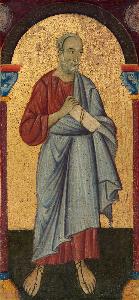Master Of Saint Francis
Master Of Saint Francis
Place: Umbria
Born: 1250
Death: 1280
Biography:
Life and Artistic Period (1250-1280)
Master Of Saint Francis, an enigmatic figure in the annals of art history, remains shrouded in mystery. This anonymous Italian painter, possibly of Pisan origin but likely trained in Umbria, worked between 1250 and 1280, leaving behind a legacy that embodies the essence of the Italo-Byzantine style.
Artistic Contributions
The Master Of Saint Francis's work is characterized by its blend of Italian and Byzantine art influences, reflecting the cultural exchange of the time. Notable for its importance in the development of early Renaissance art, this style marks a significant transition from medieval to early modern European art.
Notable Artworks and Their Significance
- Saint John the Evangelist (Tempera On Panel, circa 1250-1280): This painting, housed in a private collection, exemplifies the artist's mastery of Italo-Byzantine style. The subject, depicted with a greenish cast and dark eyes, is set against a glimmering gold background, showcasing the artist's use of color and composition.
- Other notable works, though not directly attributed, show the influence of this period in the Museum Hellenic Institute of Byzantine and Post-Byzantine Studies (Venice, Italy), which provides valuable insights into the development of Byzantine and post-Byzantine styles.
Influence on Later Artists
Giorgio de Chirico, a Metaphysical Art Movement pioneer, might have drawn inspiration from the Master Of Saint Francis's dreamlike works. Similarly, Giotto Di Bondone's Madonna and Child (10) could be seen as a continuation of the Italo-Byzantine style, further solidifying its impact on European art.
Legacy and Availability of Artworks
The Master Of Saint Francis's artworks can be found in various museums and private collections. For those interested in exploring more, [https://Wikioo.org/@@/A@D3B8BV](Museum Hellenic Institute of Byzantine and Post-Byzantine Studies) provides an extensive collection of Byzantine and post-Byzantine art, offering a deeper understanding of the Master Of Saint Francis's contributions.
- Visit [https://Wikioo.org/@/Master-Of-Saint-Francis](The Master of Saint Francis) for more information on this enigmatic artist.
- Explore [https://Wikioo.org/Art.nsf/O/A@D3B8BV](Museum Hellenic Institute of Byzantine and Post-Byzantine Studies) to delve into the world of Italo-Byzantine art.
Conclusion
The Master Of Saint Francis, though shrouded in mystery, has left an indelible mark on the development of European art. This artist's blend of Italian and Byzantine influences not only characterizes a significant period in art history but also paves the way for later artistic movements.

